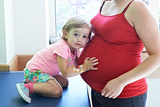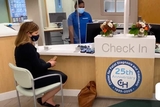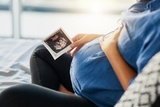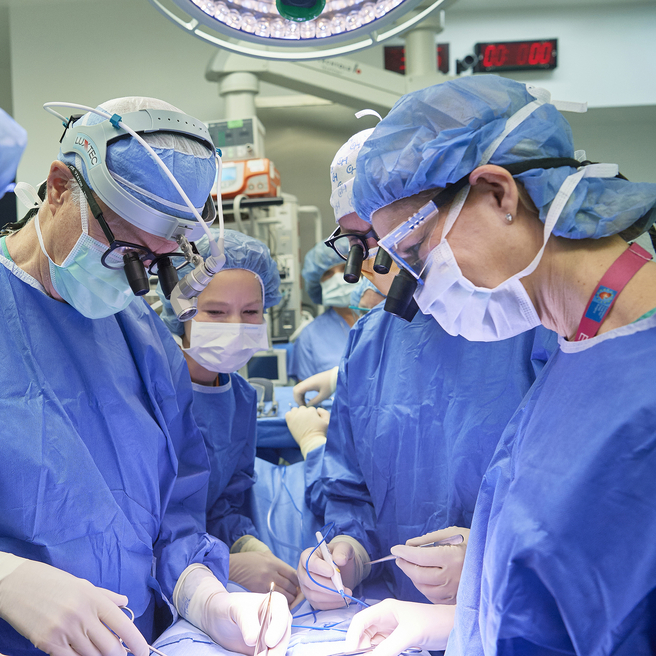What is congenital lobar emphysema?
Congenital lobar emphysema (CLE), also called congenital lobar overinflation (CLO), is a rare anomaly of fetal lung development in which an obstruction of the airways leads to an enlarged, overinflated lobe or lobes of the lung. This diagnosis may be confused with other fetal lung conditions which may look the same on prenatal ultrasound.
CLE is important to diagnose prenatally because the newborn may have trouble breathing shortly after birth and require immediate treatment. Up to 20% of babies with CLE may also have a congenital heart defect.
Causes of CLE
The cause of CLE is unclear, but are essentially divided into two types based on what is causing the obstruction.
Types of CLE
There are two types of CLE leading to hyperinflation of the lobe(s) of the lung:
- Intrinsic CLE happens when there is an obstruction from something inside the lung, such as an abnormal airway tree or bronchial cartilage acting like a one-way valve.
- Extrinsic CLE happens when there is compression of the airway by a nearby structural abnormality (such as a bronchogenic cyst) that causes pressure on the airways.
Prenatal evaluation and diagnosis of CLE
All suspected fetal lung lesions should be carefully evaluated. Determining the type, size and location of the lesion will guide treatment recommendations and outcomes. CLE may be confused with congenital cystic adenomatoid malformation (CCAM), bronchopulmonary sequestration (BPS), a hybrid lesion or congenital diaphragmatic hernia (CDH). These very similar, closely linked and unusual conditions make the diagnosis challenging.
Thanks to improvements in prenatal imaging, most lung lesions are discovered during routine ultrasounds at about 20 weeks’ gestation. In CLE, the hyperinflated lobe(s) of the lung will typically appear on the ultrasound as a bright spot in the fetus’ chest cavity. An ultrafast fetal MRI may be performed to compare with the high resolution ultrasound at the same point in time. You will also have a fetal echocardiogram to evaluate heart structure and function.
When you come to the Center for Fetal Diagnosis and Treatment, you will have a comprehensive one-day evaluation including these tests. Our fetal imaging specialists use the most advanced prenatal imaging techniques available to gather detailed information about your baby’s health and make an accurate diagnosis.
At Children’s Hospital of Philadelphia (CHOP), our fetal radiologists, maternal-fetal medicine specialists, fetal cardiologists, and fetal and pediatric surgeons have established ways to distinguish between the different types of lesions before your baby is born. This accurate diagnosis helps us create an optimal plan for the care of your child after birth.
More than 2,962 patients with suspected lung lesions have been referred to our team — this experience makes us uniquely equipped to evaluate and manage your baby’s condition.
Management of pregnancy with a CLE
Depending on the gestational age of your baby and the enlargement of the lung lobe(s), you will continue to have regular ultrasounds to closely monitor the growth of the lung lesion.
Over several visits, clinicians will determine how quickly your child’s CLE is growing. This is important in determining the location, timing and type of delivery.

Why choose CHOP for lung lesion care
CHOP provides comprehensive care for both mother and baby diagnosed with fetal lung lesions. From before birth to long-term follow-up, we are here for you every step of the way.
Delivery of babies with CLE
Mothers carrying babies with small lung lesions — without other associated anomalies — may be able to deliver at their local hospital, without the need for high-risk neonatal care. Babies with larger lesions, or those with complications or associated disorders, should be delivered in a center that offers expert care for both mother and baby in one location.
At CHOP, babies with prenatally diagnosed lung lesions who will require treatment immediately or soon after birth are delivered in the Garbose Family Special Delivery Unit (SDU), specifically designed to keep mother and baby together and avoid transport of fragile infants.
For severe cases of CLE, specialized delivery options may include:
- EXIT procedure: If the CLE is large your baby may have difficulty breathing when they’re born. An ex utero intrapartum treatment (EXIT) procedure in our Garbose Family Special Delivery Unit may be recommended.
In an EXIT procedure, your medical team will partially deliver the baby so that they are still attached to the placenta and receiving oxygen through the umbilical cord. This procedure allows time for fetal surgeons to establish an airway and remove the affected lobe. After the lobe is removed, your baby will be fully delivered and brought to the N/IICU.
- C-section to resection: More commonly, babies with CLE can be safely delivered by c-section and be carried immediately to the adjacent operating room where our expert fetal surgeons will remove the affected lobe. Our Special Delivery Unit was specifically designed with adjacent fetal operating rooms for this purpose. After the lobe is removed, our dedicated Neonatal Surgical Team will provide further specialized care for your baby.
Signs and symptoms of CLE
After birth, children with CLE may experience a variety of symptoms depending on the amount of lung affected:
- No symptoms
- Trouble breathing
- Wheezing or shortness of breath
- Fast heart rate
Here at CHOP, your baby has immediate access to the Newborn/Infant Intensive Care Unit (N/IICU) and a dedicated Neonatal Surgical Team. Our team is experienced in performing complex, delicate procedures needed to establish an airway while delivering babies who may not be able to breathe on their own at birth, as well as any immediate surgeries that your baby might need.
Surgery for CLE after birth
Timing of surgery for CLE depends upon your baby’s respiratory status.
Performing the surgery when the baby is young has multiple benefits, including promoting compensatory lung growth and avoiding potential complications such as lung infections.
A CT scan with contrast will be performed to confirm the diagnosis and determine the exact location of your child’s lung lesion. Children’s Hospital of Philadelphia radiologists have set the standard for safe, low-dose imaging practices in children.
We make every effort to schedule surgery as soon as possible and at a time convenient for your family. Surgery is often scheduled for the same week.
Follow-up care
Follow-up care for children with lung lesions will depend on the treatment the child received.
Most children treated for small lesions after birth will only need monitoring for the first year after surgery to ensure normal lung growth and lung function. The majority will require no additional long-term follow-up care.
Children treated for more severe or complex lung lesions may require ongoing monitoring through childhood. For those who experience limited lung growth resulting in pulmonary hypoplasia, CHOP’s unique Pulmonary Hypoplasia Program (PHP) offers comprehensive long-term care. The PHP team provides multidisciplinary care with a focus on improving your child’s pulmonary health, evaluating neurodevelopmental growth, meeting nutritional needs, monitoring for late onset hearing loss or any surgical issues, and more.
Long-term outlook
The vast majority of children with congenital lung lesions, including CLE, do extremely well and have normal lung function after their lesions are removed. This is thanks to rapid compensatory lung growth that occurs during childhood. Having surgery early maximizes this compensatory growth.
Children with moderate to large lesions can also do extremely well, but their outlook depends on expert treatment to avoid potential complications. These babies require highly specialized expert care from time of diagnosis to delivery and surgery to ensure the best possible long-term outcomes.

Tour our Fetal Center
The Wood Center for Fetal Diagnosis and Treatment has cared for many families and will help you through your journey, too.

What to expect
From the moment of referral through delivery and postnatal care, your family can expect a supportive experience when you come to us with a diagnosis of a birth defect.
Resources to help
Congenital Lobar Emphysema (CLE) Resources
Richard D. Wood Jr. Center for Fetal Diagnosis and Treatment Resources
Learning your baby has a birth defect is a life-changing experience. We want you to know that you are not alone. To help you find answers to your questions, we've created this list of educational health resources.
